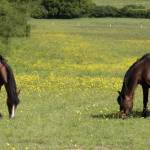Buttercups Are Toxic To Horses

As summer pastures dry out and forage growth slows, various undesirable plants seem to thrive and spread. The yellow-flowered weed known as buttercup is one of these. Horses usually won’t eat buttercups because they don’t like the taste, but in overgrazed pasture where appealing forage is in short supply, a hungry horse might give buttercups a try. The leaves and stems contain protoanemonin, a toxic oil that causes blisters in the horse’s mouth, drooling, diarrhea, and mild colic.
Offering hay, moving horses to fresh pasture, or eliminating buttercups will minimize this risk. Spraying with an herbicide will control a few buttercups, but if a pasture has a heavy infestation, it may be necessary to till the plants under and sow a pasture mix of grasses and legumes.
Local agricultural extension agents can help property owners identify buttercup and other toxic pasture plants. They can also suggest the most effective control method and advise as to the best season for weed management.








